I get a lot of banjos in my shop that need different kinds of attention. One complaint I get here in the mid-Atlantic region is that the banjo lacks soul or response. Some people claim that the banjo simply died one day. This is sometimes a clue that the tone ring and sometimes the flange fits too tightly. Humidity can do this and it is important that if you are building a banjo or having a banjo built and you like the open growl that is associated with the old Gibson sound, that your tone ring have a slip fit on a humid day. This means that the tone ring will fit loose in the winter when the heat is on in your home. After the wood rim is turned to fit the tone ring nicely, I like to let it sit, unfinished, for two weeks then test fit the tone ring again. Most of the time here is Virginia I need to take a little more off to get the fit I like.
If wood rim is fitted to the aforementioned slip fit, your tone opens up and becomes less tight or pinched sounding. On occasion I have banjos in my shop that have tone rings seemingly welded onto the wood rim because they are so tight. This is what I did for one such case:
If you look closely below, you can see that the bottom of the skirt of the tone ring is actually bulging a bit. Bulging it may be, but budging it isn’t. The first thing I do is place the wood rim and tone ring in the refrigerator over night. The humidity is very low and the temperature is not quite down to freezing. This may help. The overnight stay didn’t loosen the ring enough to remove it, so I start gently forcing it off using a long scraper blade. I place the taper end of the blade facing the wood rim and carefully use my nips to start the scraper blade, then I give it a gentle tap with the hammer. Never force anything into this area or you may damage the wood rim. When there is enough room I start using feeler gauges that are smaller than the blade. I sandwich them to protect the wood rim and the tone ring and use the blade again to get between them. You have to work on opposite sides and bring the tone ring up as uniformly all the way around as you can to avoid damage.
Click on the pictures below for a larger view
 |
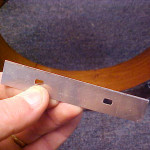 |
 |
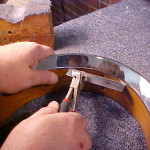 |
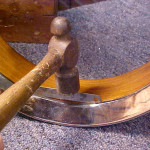 |
 |
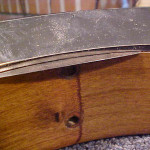 |
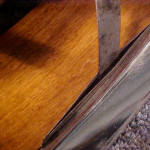 |
I keep working wood scrapers and various knives between the wood rim and the tone ring using care to keep it between the feeler gauges for protection. After it has been removed I chuck it gently into my lathe and carefully fit the ring checking the fit off the lathe to make sure I’m not taking off any more wood than is necessary. After the banjo goes back together it really opens up the bass end of the banjo.
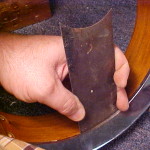 |
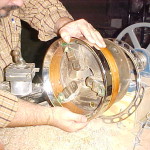 |
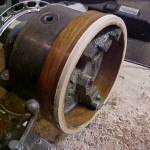 |
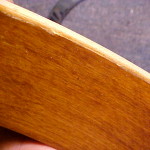 |
 |
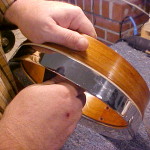 |
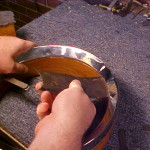 |
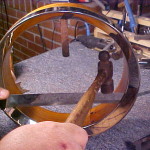 |
I hope this series has been helpful.
